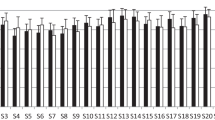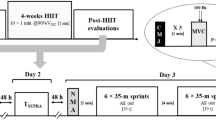Abstract
Purpose
While ideal for developing aerobic capacity, traditional endurance training (ET) is extremely time-consuming and may lack the specificity to maintain indices of speed and power in team sport athletes. In contrast, low-volume short-duration sprint interval training (SIT) has been shown to improve \({\dot{\text{V}}}\)O2max to a similar extent as ET. However, to date, few studies have compared the effects of running-based SIT and ET, on aerobic capacity and indices of speed and power of trained team sport athletes.
Methods
Club level male Gaelic football players were randomly assigned to SIT (n = 13; 26.5 ± 4.87 years) or ET (n = 12; 25.4 ± 2.58 years) groups. Participants trained 3 days week−1 for 6 weeks. \({\dot{\text{V}}}\)O2max, RE, v\({\dot{\text{V}}}\)O2max, blood lactate concentrations, Wingate test performance, running speed, jump performance and intermittent endurance performance (IEP) were measured at baseline and after 6 weeks.
Results
An increase in \({\dot{\text{V}}}\)O2max (p < 0.05), v\({\dot{\text{V}}}\)O2max (p < 0.001) and IEP (p < 0.001) following 6 weeks of both SIT and ET was observed. Wingate mean power (p < 0.001), peak power (p < 0.001) and fatigue index (p < 0.005) were all significantly improved following training in both groups. Velocity at LT was significantly higher and performance in the 20-m running speed and VJ tests were significantly reduced post training in the ET group (all p < 0.005).
Conclusion
Despite the large difference in total training time, a running-based protocol of SIT is a time efficient training method for improving aerobic capacity and IEP while maintaining indices of lower body power and running speed in team-sport players.



Similar content being viewed by others
Data availability
The data that support the findings of this study is available upon reasonable request.
Abbreviations
- BMI:
-
Body mass index
- CMJ:
-
Counter-movement jump
- COX:
-
Cytochrome c oxidase
- CPET:
-
Cardio-pulmonary exercise test
- ET:
-
Endurance training
- FI:
-
Fatigue index
- H+ :
-
Hydrogen ion
- HR:
-
Heart rate
- HRmax:
-
Maximal heart rate
- IEP:
-
Intermittent endurance performance
- LT:
-
Lactate threshold
- MCT:
-
Monocarboxylate transporter
- MP:
-
Mean power
- PAR-Q:
-
Physical activity readiness questionnaire
- PCr:
-
Phosphocreatine
- PP:
-
Peak power
- RE:
-
Running economy
- RPE:
-
Rate of perceived exertion
- SD:
-
Standard deviation
- SIT:
-
Sprint interval training
- VEmax:
-
Maximal ventilation
- VJ:
-
Vertical jump
- \({\dot{\text{V}}}\)O2 :
-
Oxygen uptake
- ̇\({\dot{\text{V}}}\)O2max:
-
Maximal aerobic capacity
- v\({\dot{\text{V}}}\)O2max:
-
Velocity at maximal oxygen uptake
References
Astorino TA, Allen RP, Roberson DW et al (2011) Adaptations to high-intensity training are independent of gender. Eur J Appl Physiol 111:1279–1286. https://doi.org/10.1007/s00421-010-1741-y
Bailey SJ, Wilkerson DP, Dimenna FJ, Jones AM (2009) Influence of repeated sprint training on pulmonary O2 uptake and muscle deoxygenation kinetics in humans. J Appl Physiol 106:1875–1887. https://doi.org/10.1152/japplphysiol.00144.2009
Borg G (1998) Borg’s perceived exertion and pain scales. Human Kinetics, Champaign, IL
Buchheit M, Laursen PB (2013a) High-intensity interval training, solutions to the programming puzzle: Part II: anaerobic energy, neuromuscular load and practical applications. Sport Med 43:927–954. https://doi.org/10.1007/s40279-013-0066-5
Buchheit M, Laursen PB (2013b) High-intensity interval training, solutions to the programming puzzle: Part I: cardiopulmonary emphasis. Sports Med 43:313–338. https://doi.org/10.1007/s40279-013-0029-x
Burgomaster KA, Heigenhauser GJF, Gibala MJ, Kirsten A (2006) Effect of short-term sprint interval training on human skeletal muscle carbohydrate metabolism during exercise and time-trial performance. J Appl Physiol 100:2041–2047. https://doi.org/10.1152/japplphysiol.01220.2005
Burgomaster KA, Cermak NM, Phillips SM et al (2007) Divergent response of metabolite transport proteins in human skeletal muscle after sprint interval training and detraining. Am J Physiol Regul Integr Comp Physiol 292:R1970–R1976. https://doi.org/10.1152/ajpregu.00503.2006
Burgomaster K, Howarth KR, Phillips SM et al (2008) Similar metabolic adaptations during exercise after low volume sprint interval and traditional endurance training in humans. J Physiol 586:151–160. https://doi.org/10.1113/jphysiol.2007.142109
Cocks M, Shaw CS, Shepherd SO et al (2013) Sprint interval and endurance training are equally effective in increasing muscle microvascular density and eNOS content in sedentary males. J Physiol 591:641–656. https://doi.org/10.1113/jphysiol.2012.239566
Cullen B, Cregg C, Kelly D et al (2012) Fitness profiling of elite level adolescent Gaelic football players. J Strength Cond Res 27:2096–2103
Daly LS, Catháin CÓ, Kelly DT (2020) Gaelic football match-play: performance attenuation and timeline of recovery. Sports 8:166. https://doi.org/10.3390/sports8120166
Evertsen F, Medbø JI, Bonen A (2001) Effect of training intensity on muscle lactate transporters and lactate threshold of cross-country skiers. Acta Physiol Scand 173:195–205. https://doi.org/10.1046/j.1365-201X.2001.00871.x
Gabbett T, Kelly J, Ralph S, Driscoll D (2009) Physiological and anthropometric characteristics of junior elite and sub-elite rugby league players, with special reference to starters and non-starters. J Sci Med Sport 12:215–222. https://doi.org/10.1016/j.jsams.2007.06.008
Gaesser GA, Poole DC, Gardner BP (1984) Dissociation between VO2max and ventilatory threshold responses to endurance training. J Appl Physiol Occup Physiol 53:242–247
Gibala MJ, Little JP, van Essen M et al (2006) Short-term sprint interval versus traditional endurance training: similar initial adaptations in human skeletal muscle and exercise performance. J Physiol 575:901–911. https://doi.org/10.1113/jphysiol.2006.112094
Hazell TJ, Macpherson REK, Gravelle BMR, Lemon PWR (2010) 10 or 30-s sprint interval training bouts enhance both aerobic and anaerobic performance. Eur J Appl Physiol 110:153–160. https://doi.org/10.1007/s00421-010-1474-y
Helgerud J, Engen LC, Wisloff U, Hoff J (2001) Aerobic endurance training improves soccer performance. Med Sci Sports Exerc 33:1925–1931
Helgerud J, Wang E, Karlsen T, Berg P (2007) Aerobic high-intensity intervals improve VO2max more than moderate training. Med Sci Sport Exerc Sci 39:665–672
Henneman E, Clamann PH (1974) Rank order of motoneurons within a pool: law of combination. J Neurophysiol 37:1338–1349
Hennessy LC, Watson WS (1994) The interference effects of training for strength and endurance simultaneously.pdf. J Strength Cond Res 8:12–19
Henritze J, Weltman A, Schurrer RL, Barlow K (1985) Effects of training at and above the lactate threshold on the lactate threshold and maximal oxygen uptake. Eur J Appl Physiol Occup Physiol 54:84–88
Hickson RC, Hagberg JM, Ehsani AA, Holloszy JO (1981) Time course of the adaptive responses of aerobic power and heart rate to training. Med Sci Sports Exerc 13:17–20
Holloszy JO, Coyle EF (1984) Adaptations of skeletal muscle to endurance exercise and their metabolic consequences. J Appl Physiol 56:831–838
Hume P, Marfell-Jones M (2008) The importance of accurate site location for skinfold measurement. J Sports Sci 26:1333–1340. https://doi.org/10.1080/02640410802165707
Iaia FM, Hellsten Y, Nielsen JJ et al (2009) Four weeks of speed endurance training reduces energy expenditure during exercise and maintains muscle oxidative capacity despite a reduction in training volume. J Appl Physiol 106:73–80. https://doi.org/10.1152/japplphysiol.90676.2008
Jackson AS, Pollock M (1978) Generalised equation for predicting body density of men. Br J Nutr 40:497–504
Jones AM, Carter H (2000) The effect of endurance training on parameters of aerobic fitness. Sports Med 29:373–386
Kawamori N, Haff G (2004) The optimal training load for the development of muscular power. J Strength Cond Res 18:675–684
Kelly DT, Tobin C, Egan B et al (2018) Comparison of sprint interval and endurance training in team sport athletes. J Strength Cond Res 32:3051–3058. https://doi.org/10.1519/JSC.0000000000002374
Laursen PB, Jenkins DG (2002) The scientific basis for high-intensity interval training: optimising training programmes and maximising performance in highly trained endurance athletes. Sports Med 32:53–73
Little JP, Safdar A, Wilkin GP et al (2010) A practical model of low-volume high-intensity interval training induces mitochondrial biogenesis in human skeletal muscle: potential mechanisms. J Physiol 588:1011–1022. https://doi.org/10.1113/jphysiol.2009.181743
Londeree BR (1997) Effect of training on lactate/ventilatory thresholds: a meta-analysis. Med Sci Sports Exerc 29:837–843
MacDougall JD, Hicks AL, MacDonald JR et al (1998) Muscle performance and enzymatic adaptations to sprint interval training. J Appl Physiol 84:2138–2142
MacInnis MJ, Gibala MJ (2017) Physiological adaptations to interval training and the role of exercise intensity. J Physiol 595:2915–2930. https://doi.org/10.1113/JP273196
Macpherson TW, Weston M (2015) The effect of low-volume sprint interval training on the development and subsequent maintenance of aerobic fitness in soccer players. Int J Sports Physiol Perform 10:332–338
Macpherson REK, Hazell TJ, Olver TD et al (2011) Run sprint interval training improves aerobic performance but not maximal cardiac output. Med Sci Sports Exerc 43:115–122. https://doi.org/10.1249/MSS.0b013e3181e5eacd
Mangan S, Collins K, Burns C, O’Neill C (2020) The positional technical and running performance of sub-elite Gaelic football. Sci Med Footb 4:182–191. https://doi.org/10.1080/24733938.2019.1679872
McMahon S, Jenkins D (2002) Factors affecting the rate of phosphocreatine resynthesis following intense exercise. Sport Med 32:761–784
Milanović Z, Sporiš G, Weston M (2015) Effectiveness of high-intensity interval training (HIT) and Continuous endurance training for VO2max improvements: a systematic review and meta-analysis of controlled trials. Sport Med 45:1469–1481. https://doi.org/10.1007/s40279-015-0365-0
Nazarali P, Rajabi H, Aliabadi F (2013) The relationship between laboratory, yoyo, and hoff tests in determining aerobic capacity of players of the national women ’ s soccer team. Ann Appl Sport Sci 1:57–66
Nelson AG, Arnall D, Sweat D (1990) Consequences of combining strength and endurance training regimens. Phys Ther. https://doi.org/10.1093/ptj/70.5.287
Purkhús E, Krustrup P, Mohr M (2016) High intensity training improves exercise performance in elite women volleyball players during a competitive season. J Strength Cond Res 30:3066–3072. https://doi.org/10.1519/JSC.0000000000001408
Pyne DB, Gardner S, Sheehan K, Hopkins WG (2005) Fitness testing and career progression in AFL football. J Sci Med Sport 8:321–332
Reilly T, Collins K (2008) Science and the Gaelic sports: Gaelic football and hurling. Eur J Sport Sci 8:231–240. https://doi.org/10.1080/17461390802251851
Rowan AE, Kueffner TE, Stavrianeas S (2012) Short duration high-intensity interval training improves aerobic conditioning of female college soccer players. Int J Exerc Sci 5:232–238
Schiaffino S, Reggiani C (2011) Fiber types in mammalian skeletal muscles. Physiol Rev 91:1447–1531. https://doi.org/10.1152/physrev.00031.2010
Sperlich B, Koehler K (2011) Effects of 5 weeks’ high-intensity interval training vs. volume training in 14-year-old soccer players. J Strength Cond Res 25:1271–1278
Sperlich B, De MM et al (2011) Effects of 5 weeks’ high-intensity interval training vs. volume training in 14-year-old soccer players. J Strength Cond Res 25:1271–1278
Spina RJ, Chi MM, Hopkins MG et al (1996) Mitochondrial enzymes increase in muscle in response to 7–10 days of cycle exercise. J Appl Physiol 80:2250
Stewart A, Marfell-Jones M, Olds T, De Ridder J (2011) International Standards for Anthropometric Assessment. ISAK, Potchefstroom, South Africa
Young WB (2006) Transfer of strength and power training to sports performance. Int J Sports Physiol Perform 1:74–83
Zajac A, Jarzabek R, Waskiewicz Z (1999) The diagnostic value of the 10- and 30-second wingate test for competitive athletes. J Strength Cond Res 13:16–19. https://doi.org/10.1519/00124278-199902000-00003
Acknowledgements
The authors would like to sincerely thank the final year project students as well as the committed participants that contributed to and participated in this study.
Funding
The authors did not receive support from any organization for the submitted work.
Author information
Authors and Affiliations
Contributions
DTK, CC and NMM conceived and designed research. DTK, CC, BC and POC conducted experiments. DTK and NMM analysed data. The first draft of the manuscript was written by DTK and all authors commented on previous versions of the manuscript. All authors read and approved the final manuscript.
Corresponding author
Ethics declarations
Conflict of interest
None of the authors have a conflict of interest to declare.
Ethical approval
Dublin City University Ethical Committee approved the study and included procedures/analyses.
Consent to participate
Participants gave their written informed consent to take part in the present investigation.
Consent for publication
The present authors all consent to the publication of this work.
Additional information
Communicated by Westerterp/Westerblad.
Publisher's Note
Springer Nature remains neutral with regard to jurisdictional claims in published maps and institutional affiliations.
Rights and permissions
About this article
Cite this article
Kelly, D.T., Cregg, C.J., O’Connor, P.L. et al. Physiological and performance responses of sprint interval training and endurance training in Gaelic football players. Eur J Appl Physiol 121, 2265–2275 (2021). https://doi.org/10.1007/s00421-021-04699-0
Received:
Accepted:
Published:
Issue Date:
DOI: https://doi.org/10.1007/s00421-021-04699-0




